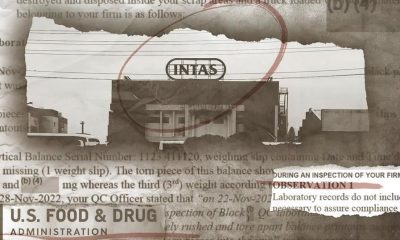Art
Exhibition celebrates strength, beauty, struggle of Black community in Saint John
Kenneth Scott’s passion project started out with a simple question: “Would the Black community here in Saint John be interested in seeing an exhibition of photographs of the Black community from yesteryear?” Scott said.
The packed exhibition room at the Saint John Arts Centre on opening night suggested that Saint Johners, Black or otherwise, would.
Scott’s exhibition of vintage photographs, A time, A place, Our gaze, at the Saint John Arts Centre, celebrates a roughly 40-year span of history captured in 80 to 90 photographs.
The photos, taken with what Scott called a “friendly camera,” had a purpose: to show everyday people living their lives.

“The people that you see are probably happy and obliging to have their photograph taken and with that you can see their inner strength, their beauty,” he said.
“And at a time when, media-wise, we weren’t portrayed — we were caricatured … these photos kind of reinsert us into the grand narrative of the city.”
Born and raised in the port city, Kenneth Scott has assembled a collection of rare portraits and snapshots of its Black community, from the 1910s to the late 1950s.
Scott, a retired teacher, left Saint John to pursue his career in Ontario when he was 21. While he now lives in Toronto, he is still connected to the city through his mother and cares deeply about promoting the history of the Black community of the city.
He hopes that his exhibition can serve as a model for looking at history from the bottom up, instead of the top down, and to encourage others to see what pieces of history they may have hidden in their homes.
“We all have photographs, artifacts, mementos, parts of our history that don’t get a lot of attention but are profoundly important as the big curated shows by the people who get more media attention,” Scott said.
“I’m hoping that someone comes to this exhibition, they look around and say, ‘You know what, I’m going to go back to my house and go under the bed or in the closet and pull out my family photographs and decide how I want to share my family history with the wider community.'”
Looking into the past
Scott encourages people to look deeper, not just at what the photos depict, but what they suggest about the times.
“If you look into the pictures, instead of just looking at the pictures, you can also get a sense of the social and geographical areas that they lived in. There was poverty and racial containment, but it didn’t always define who we were,” he said.
“There’s a certain energy … it captured the humanity of people who spent a lot of time being dehumanized.”

Scott gathered many photos from his own family albums and got others by buying negatives. That’s how he obtained the picture of Bernice Dixon, which originally appeared in former Evening Times Globe newspaper.
On either side of her, “it gives the viewer an indication of what it would look like to live where she lived. The photograph was taken in a place called Union Alley,” Scott said.
The alley ran off the block between Coburg and Waterloo, behind what was once a popular store.
“If you’re looking at the Ideal department store, you went up a set of stairs and you were into Union Alley, which is a set of about probably 11 or 12 three-storey tenement houses,” he said.
“Cheap rents, a whole lot of disrepair … looking into the photograph you see ash and garbage.”
The picture was taken the day after a fire in one of the tenement houses.
“She apparently was very heroic on that day and helped children get out of the building, and she spent a little bit of time in hospital,” Scott said.

Drawn to the “quiet dignity in her pose,” Scott said he deliberated on whether or not he should crop the photograph, not wanting Dixon to be perceived negatively.
“But I thought it was important to leave the bottom part here, where you notice that she’s not wearing a shoe,” he said.
“I love this photo and on a very personal level, because my family also lived in this. She was a neighbour of my great-grandmother before they moved out of there.”
Examples of survival
New Brunswick Black History Society founder Ralph Thomas says Union Alley is an example of the city’s Black community “surviving.”
An example of “Black communities advancing Black communities, being on a next level of existing in the city of Saint John, in the province of New Brunswick. It’s a great example of ‘Yes we can,'” Thomas said.
Like Scott, Thomas said such photos offer a glimpse into the struggles of the time.
“We had situations, we had racism, we had discrimination, things going on that we battled … some of our strong leaders came from Union Alley,” he said.
“It’s one of the examples of the struggles that Black folks went through and came out winners.”
To Thomas, the pictures in this exhibition also serve as motivation.
“The photos show smiles on peoples’ faces,” he said. “And that alone tells us how we grew from the sad times and the grim faces and the hard times — just to exist.
“And to see those pictures sort of gives you that extra push, that — ‘Hey, they could smile back then when times were really severe. Hey, that’s a great example for what we can do moving forward with the help of everybody.'”
The exhibition will run until March 8.

Art
Art Gallery of Ontario accepts one of its largest ever private art donations – The Globe and Mail
[unable to retrieve full-text content]
- Art Gallery of Ontario accepts one of its largest ever private art donations The Globe and Mail
- Art Gallery of Ontario receives 37 works from late telecoms executive’s estate Art Newspaper
- Art Gallery of Ontario accepts one of its largest ever private art donations Yahoo News Canada
Art
We surprise a six-year-old whose art portfolio and community donations keep growing – BayToday.ca
[unable to retrieve full-text content]
We surprise a six-year-old whose art portfolio and community donations keep growing BayToday.ca

Source link
Art
Ukrainian sells art in Essex while stuck in a warzone – BBC.com
[unable to retrieve full-text content]
Ukrainian sells art in Essex while stuck in a warzone BBC.com

Source link
-

 News15 hours ago
News15 hours agoUgandan Olympic athlete dies after being severely burned by her partner over a land dispute
-
Health14 hours ago
ProstaClear: Simple Hacks Any Man Can Use To Support a Healthy Prostate
-

 News10 hours ago
News10 hours agoPrince Harry and Matt Damon set to address this year’s Clinton Global Initiative annual meeting
-

 Politics14 hours ago
Politics14 hours agoNova Scotia legislature returns for fall sitting amid early election speculation
-

 Health12 hours ago
Health12 hours agoAcid Reflux sl cb – case study
-

 Health22 hours ago
Health22 hours agoManhood Miracle
-

 Health20 hours ago
Health20 hours agoAncient Tonic Discovered 6,092 Years Ago By “Seer Of The Gods”… Boosts T — Restores “Horse Power” Libido And Energy In Just 8 Seconds…
-

 News9 hours ago
News9 hours agoNearly 2,000 drug plants are overdue for FDA checks after COVID delays, AP finds




















